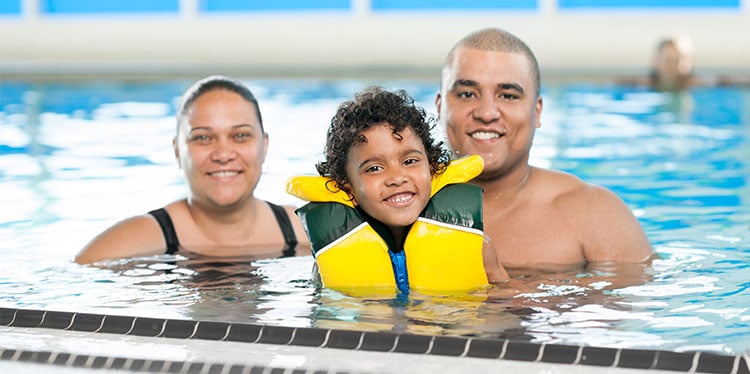The grizzly bear in your (neighbor’s) backyard

My three-year-old daughter was testing limits like most toddlers while we were visiting family a few weeks ago, and she fell into their swimming pool. She thought it cute to keep moving her chair backward despite several warnings until the chair toppled over and she went head-first into the water! Her grandpa immediately jumped in and got her out in less than 3 seconds. My daughter was only mildly ruffled by this pool accident. However, this made me think of many toddlers across the world who have drowned in swimming pools. My heart goes out to all parents who have lost a child to drowning, as well as parents whose children have suffered irreversible brain damage from nonfatal drowning. According to experts, a toddler can drown in less than 20 seconds, and it usually happens silently.
The most recent CDC data reveals that unintentional drowning is the leading cause of death due to injury in American children aged 1 to 4 years, and it ranks second for 5 to 9-year-old children. More than 10,000 children under 10 years old died as a result of unintentional drowning in the US between the years 2000 and 2017. Over 100 of those childhood deaths happened here in Minnesota[1]. In this post, I share three safety tips to keep children safe from this preventable danger while enjoying swimming pools this summer.
Water safety tips for parents
Most importantly, parents need to know that unanticipated access is the reason most children drown in swimming pools, or any body of water including bathtubs, toilets, and lakes. This point was emphasized by two mothers, Morgan Miller and Nicole Hughes, who lost their toddlers to a swimming pool drowning on the same day last year. Like Nicole, parents are careful about putting a life vest on their toddlers when they take them to swim or bring them around open bodies of water. However, it is those moments when toddlers are not expected to be near or in water that most drownings occur.
There is no substitute for close supervision of children. The American Academy of Pediatrics recommends ‘touch supervision’ for all toddlers. This means that the toddler must have an adult next to them in the pool. Personal flotation devices are not a substitute for adult contact. Children should not be watched by older children. Older children who can swim should have a designated supervising adult, a ‘water watcher’ constantly focused on them. The water watcher should keep their eyes on the child(ren) at all times, without distraction. The designated pool watcher should be able to recognize signs of drowning. At public pools, parents should recognize that the presence of a lifeguard is not a guarantee against drowning. Children should always be closely supervised.
Preventing access using physical barriers is another important precaution. Fences with self-closing and self-latching gates isolating a swimming pool from the home can prevent more than 50% of swimming pool drownings of young children. Other devices such as pool covers, pool alarms, and door/ window alarms may also prevent curious toddlers from exploring dangerously. Environmental modifications to stop children from unanticipated and thus unattended pool access are essential because adults and children alike can be caught off guard.
Swimming lessons provide a life skill for children and I encourage families to start from the first birthday if the child seems ready and is likely to have a lot of contact with water. The risk of drowning is decreased by swimming lessons for children 1 to 4 years old. The American Academy of Pediatrics recommends that all children 4 years and older take swimming lessons.
There are free and low-cost swim lessons available for children in Hennepin County.
We are implementing these strategies in my family to keep our daughter safe around water bodies. You can also do three things this summer: closely supervise your child(ren), maintain a physical barrier around the swimming pool, and take swimming lessons. I should mention that my daughter is currently participating in swimming lessons at our local community center and loving it!
 Ifelayo Ojo, MD
Ifelayo Ojo, MD
Dr. Ojo is a general pediatrician with global health training and a strong interest in equitable access to healthcare and preventive services. He provides medical care to children from birth to age 21. After completing medical school, an internship, and a brief period of practice in Nigeria, he proceeded to the US for public health training and graduate medical education. He is passionate about medical education and is involved with training medical students and residents at home and abroad.
Dr. Ojo sees patients at St. Anthony Village Clinic & Pharmacy and Brooklyn Park Clinic & Pharmacy.
Helpful Resources
- The American Academy of Pediatrics recently launched this Water Safety website with infographics for new parents, and each stage of a child’s growth into the teen years.
- How to Plan For the Unexpected – Prevent Child Drownings by United States Consumer Product Safety Commission. This and other helpful Pool and Spa safety guides can be accessed through this link.
- Do You Know What Drowning Looks Like? By Utah Valley Pediatrics
- Swim Lessons: When to Start & What Parents Should Know by the American Academy of Pediatrics
Safekids.org Water Safety Infographic
water-safety-infographic-long-version
[1] Data analysis performed using WISQARS™ https://webappa.cdc.gov/cgi-bin/broker.exe. Accessed June 19, 2019. Data Source: National Center for Health Statistics (NCHS), National Vital Statistics System.


